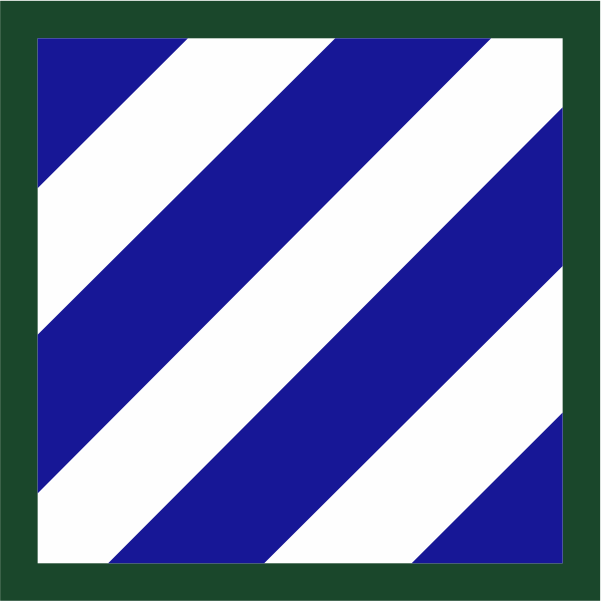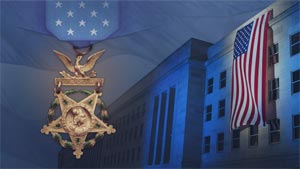MEDAL OF HONOR
Korean WarPrivate First Class Charles R. Johnson

hometown
Millbrook, New York
Enlistment date
1952
Military Occupation (MOS)
Infantryman (11B)
Unit
Company B, 15th Infantry Regiment, 3rd Infantry Division
Deployments
Korea, 1953
Charles R. Johnson was born Aug. 11, 1932, in Millbrook, New York, to Robert and Pearl Johnson. He was the third of six children, and his family called him “Buddy.” He was a very talented athlete and musician who lettered in football, baseball and basketball, played the trumpet and sang in the choir.
Johnson attended Millbrook High School for three years, and transferred to Arlington High School in Poughkeepsie, New York, for his senior year, where he was elected as class vice president and served as co-captain of the basketball team. He was also selected by his schoolmates to receive the Babe Ruth Award for good sportsmanship and fair play.
 Charles R. Johnson. Photo courtesy of the Johnson family.
Charles R. Johnson. Photo courtesy of the Johnson family.
Johnson attended Howard University for one semester in the fall of 1951 and played for their football team. In 1952 he was drafted into the military. His sister Geraldine urged him to join the Army band, but he told her, “If other mother's sons have to fight, I feel I need to do the same thing.”
Pfc. Charles R. Johnson distinguished himself while serving with Company B, 15th Infantry Regiment, 3rd Infantry Division, while defending Outpost Harry against overwhelming odds, and making the ultimate sacrifice to save the lives of his comrades in the Republic of Korea during the period of June 11-12, 1953.
He was serving as a Browning automatic rifleman when Chinese forces attacked his unit during a massive nighttime assault involving more than 3,000 enemy soldiers. Johnson fought alongside his high school friend, Pvt. Don Dingee, who he later dragged to safety after their bunker was attacked by grenades.
"Charlie was a great Soldier, and the word hesitation was not in his vocabulary," Dingee later recalled. In addition, Johnson administered first aid to other injured Soldiers, despite being wounded himself. After recognizing their situation as untenable, and with disregard for his personal safety, he placed himself between the enemy and his injured comrades, and told them he would hold off the enemy forces as best as he could. His brave and selfless efforts saved the lives of as many as 10 Soldiers.
The Silver Star Medal, the third highest Department of Defense award exclusively for valor in combat, was posthumously awarded to Johnson in 2010, 57 years after his valiant actions. He was also honored in 2014 when the Johnson Fitness Center at Fort Stewart, Georgia — an 80,000 foot facility that features an indoor swimming pool, running track, climbing wall and cardio rooms — was named after him under the 3rd Infantry Division.
At Arlington High School, there is a Charlie Johnson Hall, which features a bronze statue of Johnson pulling Dingee to safety, and a Wall of Remembrance that lists the names and stories of Arlington alumni who were killed in action while serving in the armed forces.
Johnson's friends and classmates, along with students, staff and administrators from the Arlington School District, established the Charlie Johnson Legacy Project, which helps teach lessons inspired by Johnson, including loyalty, brotherhood, selflessness, courage, compassion, responsibility, patriotism and integrity. Each year the project awards scholarships to male and female students who reflect the most Charlie Johnson-like qualities.
 Fellow Arlington High School classmate and teammate Donald Dingee (left), 3rd Infantry Division-Rear Command Sgt. Maj. Jeffrey Ashmen, 3rd Infantry Division Deputy Commanding Brig. Gen. Jeffrey Phillips and sculptor Arden Witherwax unveiled a sculpture depicting Johnson pulling Don Dingee to safety at Outpost Harry during a Silver Star ceremony at Arlington High School in LaGrangeville, New York.
Fellow Arlington High School classmate and teammate Donald Dingee (left), 3rd Infantry Division-Rear Command Sgt. Maj. Jeffrey Ashmen, 3rd Infantry Division Deputy Commanding Brig. Gen. Jeffrey Phillips and sculptor Arden Witherwax unveiled a sculpture depicting Johnson pulling Don Dingee to safety at Outpost Harry during a Silver Star ceremony at Arlington High School in LaGrangeville, New York.
The Battle
Unyielding courage and bravery
June 11-12, 1953 | Outpost Harry, Korean Peninsula

3rd Infantry Division
Shoulder sleeve insignia of the 3rd Infantry Division, consisting of three white stripes upon a blue square. Read Full Unit History
Pfc. Charles R. Johnson distinguished himself by conspicuous gallantry and intrepidity beyond the call of duty while defending Outpost Harry against overwhelming odds, and making the ultimate sacrifice to save the lives of his comrades in the Republic of Korea, June 11-12, 1953.
Johnson was serving as a Browning automatic rifleman with Company B, 15th Infantry Regiment, 3rd Infantry Division, when Chinese forces attacked his unit during a massive nighttime assault. During the ensuing battle, overwhelming numbers of Chinese troops assaulted the trenches and bunkers defended by Johnson and his squad.
Johnson, wounded from a direct artillery hit on his bunker and subsequently from a hand grenade, administered first aid to those more seriously injured. Understanding the seriousness of the situation and being under direct fire from the enemy, Johnson dragged a wounded Soldier to a secure bunker, stopping intermittently to aid injured Soldiers and kill several enemy troops in hand-to-hand combat.
Departing the safety of the second bunker, he conducted a search for weapons and ammunition, then returned to rearm the others. After recognizing their situation as untenable, and with disregard for his personal safety, he exited the bunker, placing himself between the enemy and his injured comrades, and told them he would hold off the enemy forces as best as he could.
His brave and selfless efforts saved the lives of as many as 10 Soldiers. Johnson's extraordinary actions in close combat with the enemy, his unyielding courage and bravery, and his profound concern for his fellow Soldiers are in keeping with the highest traditions of military service and reflect great credit upon himself, his unit and the United States Army.
RELATED STORIES FROM ARMY.MIL
3rd Infantry Division

3rd Infantry Division
The three white stripes of the insignia are symbolic of the three major operations in which the division participated during World War I. The blue field symbolizes the loyalty of those who placed their lives on the altar of self-sacrifice in defense of the American ideals of liberty and democracy.
Assigned to the 3rd Infantry Division from 1940 to 1957, the 2nd Battalion, 15th Infantry Regiment (“The Old China Hands”), fought as part of “The Rock of the Marne” through World War II and the Korean War.
The 3rd Infantry Division was constituted on Nov. 12, 1917, in the regular Army as Headquarters, 3rd Division, and organized on Nov. 21, 1917, at Camp Greene, North Carolina, for service in World War I. Eight months later, the division saw combat for the first time in France. At midnight on July 14, 1918, the division earned its nickname on the banks of the Marne River in France while holding the Allied forces' line against a German onslaught. During the war, two members of the division were awarded the Medal of Honor.
During World War II, the 3rd Infantry Division was one of the few American divisions that fought the Axis on all European fronts and was among the first U.S. combat units to engage in offensive ground combat operations. The division first saw action as part of the Western Task Force during the North African invasion, landing at Fedala, Morocco, on Nov. 8, 1942, before capturing half of French Morocco. The 3rd Division participated in major battles from 1942-1945 against Italian and German forces in Italy and France and ended their participation in the war in Germany by taking Nuremberg and moving south toward Munich. The 3rd Division suffered more combat deaths in World War II than any other U.S. division and ranks as the third highest among modern U.S. divisions, behind only the 2nd Infantry Division in the Korean War and the 1st Cavalry Division in the Vietnam War.
During the Korean War, Gen. Douglas MacArthur specifically asked for the 3rd Infantry Division to be deployed to his Far East Command, considering it highly capable and combat-ready. The division became known as “The Fire Brigade” for its ability to quickly cover breaks in the United Nations’ lines. In May 1951, the division was given orders to disengage on the east coast and move all the way across Korea to stop a major enemy breakthrough in the west. Members of the Fire Brigade received eight Battle Stars and 13 Medals of Honor, bringing the total number of Medals of Honor earned by its members to 54.
From April 1958 to April 1996, the Marne Division was stationed with the VII Corps in West Germany near the Czech border throughout various towns, including Würzburg, Schweinfurt, Kitzingen and Aschaffenburg. In November 1990, Soldiers of the 3rd Infantry Division were once again called into action. Following Iraq's invasion of Kuwait, more than 6,000 Marne men and women deployed with the 1st Armored Division as part of Operation Desert Storm until September 1991.
In 2003, the Marne Division demonstrated that it was the premier mechanized force in the world by leading the advance up the Euphrates River Valley in Iraq. The 3rd Infantry Division crushed several fiercely defended positions before reaching Saddam International Airport and the Al Faw Palace on the western side of Baghdad in early April 2003. Several days later, the 2nd Brigade made two daring “Thunder Runs” into the middle of Baghdad, the second of which culminated in the toppling of the Saddam Hussein statue with a mechanized recovery vehicle. Following the fall of the regime and further operations in Baghdad and Anbar, the division returned to the United States in August 2003. By early 2007, the entire division had returned to Iraq as part of the “Surge.” The division headquarters became the core of a newly formed Multi-National Division - Central that operated in the “southern belts” on the edge of Baghdad. Under the new modular organization, the 3rd Infantry Division deployed its headquarters and brigade combat teams to different locations throughout 2009 and 2010. This series of deployments marked the fourth time the division deployed to Iraq, the most of any division.
The 3rd Infantry Division’s role in Operation Enduring Freedom has been characterized by the flexible and modular nature of the elements that make up the whole of the division. The 3rd Infantry Division conducted a series of deployments to Afghanistan from November 2009 through April 2018, serving as Regional Command-South Headquarters from 2012-2013, as elements of Joint Task Force 3 from 2013-2015 and participating in Operation Resolute Support from 2017-2018.
The 3rd Infantry Division boasts a storied history of valorous service in World War I, World War II, Korea and Operations Iraqi Freedom and New Dawn. Additionally, units from the division deployed and fought in Operations Desert Storm and Enduring Freedom. It was the first conventional U.S. unit to enter Baghdad during the 2003 invasion and the first division to serve four tours in Iraq. Its combat record was earned at the high price of more than 50,000 wartime casualties. Fifty-five members of the 3rd Infantry Division have been awarded the Medal of Honor, more than any other division.

